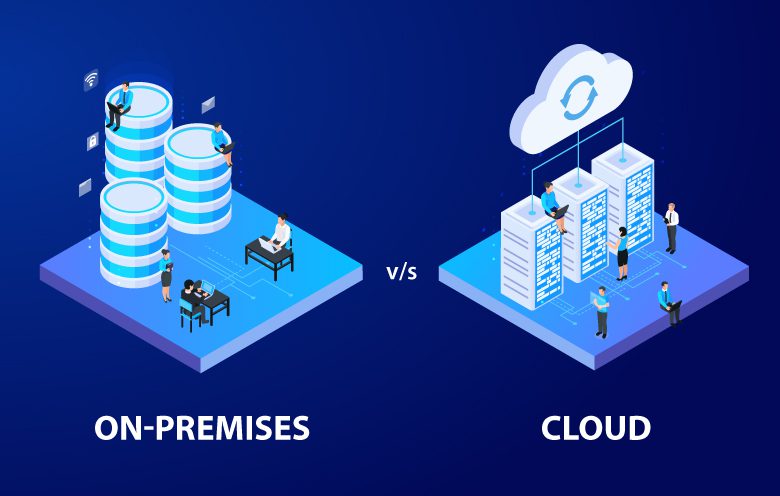Running a small business is never easy. You constantly make decisions that impact your growth, efficiency, and costs. One of the most important decisions is about your IT systems. Should you move your data and applications to the cloud, or should you keep everything on-premises? Both options have their advantages and challenges. Choosing the right one can save you money, simplify operations, and even help your business grow faster. In this blog, we will explore both options in detail and help you understand which one is better for small businesses.
What is Cloud Computing?
Cloud computing means storing and running your data, applications, and software on servers that are managed by a third-party provider. Instead of buying physical servers and maintaining them in your office, you rent space and services from a provider and access everything over the internet. Think of it as renting a fully-equipped office instead of buying a building.
Benefits for Small Businesses
Cloud computing offers several advantages for small businesses:
- Lower Upfront Costs – Cloud solutions reduce the need to buy expensive hardware. You only pay for what you use, usually through a subscription model. This is especially helpful for businesses that have limited budgets but want to access advanced technology.
- Scalability – As your business grows, you can scale your cloud resources up or down. You don’t need to buy new servers every time your storage or computing needs increase.
- Remote Access – Cloud services allow your employees to access applications and data from anywhere. Whether your team is in the office, at home, or traveling, they can stay connected and productive.
- Reduced IT Maintenance – Your cloud provider handles updates, patches, and server maintenance. Your in-house team can focus on tasks that directly contribute to business growth instead of spending time fixing servers.
- Faster Deployment – Deploying applications in the cloud is much faster than setting up servers on-premises. This means you can introduce new tools and services quickly without disrupting your business.
Challenges of Cloud Computing
Despite its many advantages, the cloud does come with some challenges:
- Dependence on Internet – Since all cloud services rely on the internet, any downtime or slow connection can impact productivity.
- Ongoing Costs – While cloud solutions reduce upfront investment, subscription fees can add up over time. You need to monitor costs and usage regularly.
- Data Security Concerns – Even though cloud providers invest heavily in security, some businesses prefer to keep sensitive data on-premises for full control.
What is On-Premises IT?
On-premises IT means that your business owns and manages servers and IT infrastructure inside your office or facility. You buy hardware, install software, and maintain everything yourself or through an internal IT team.
Benefits of On-Premises
For some businesses, on-premises IT is still the preferred choice because of the following reasons:
- Full Control – You have complete control over your systems, data, and network. You decide how everything is set up and who has access.
- High Customization – On-premises systems allow deep customization of software and infrastructure according to your business needs. You can design your systems exactly how you want them.
- Enhanced Security – When managed properly, on-premises solutions can provide strong security. Data remains within your office, reducing potential exposure to third-party risks.
Challenges of On-Premises
On the downside, on-premises IT comes with challenges that small businesses need to consider:
- High Upfront Cost – Buying servers, storage, networking equipment, and software licenses requires significant capital investment.
- Maintenance Responsibility – Your team is responsible for all updates, patches, and troubleshooting. Any downtime or technical issue is your responsibility.
- Limited Scalability – Scaling your systems requires buying additional hardware and often reconfiguring your network. This can be costly and time-consuming.
Which Option is Better for Small Businesses?
For most small businesses, cloud computing is the smarter choice. It reduces upfront costs, minimizes maintenance headaches, and provides flexibility as your business grows. Cloud solutions are particularly suitable if you want:
- Remote work capabilities
- Quick deployment of new tools
- Easy scalability without major investment
On-premises makes sense only in specific situations:
- Your business handles extremely sensitive data that cannot leave your office.
- You have strict compliance or regulatory requirements.
- You need highly customized software that the cloud cannot accommodate.
Many businesses adopt a hybrid approach, combining cloud and on-premises systems. Core systems that require control or compliance stay on-premises, while other applications and services move to the cloud. This approach provides flexibility, control, and cost-effectiveness.
Practical Tips for Small Businesses
Here are some tips to make the most of your IT investment:
- Start Small and Scale – If you choose the cloud, begin with essential services and expand as your business grows. Avoid investing in more resources than you currently need.
- Backup Everything – Even cloud services can fail. Keep a reliable backup strategy for your critical data to ensure business continuity.
- Focus on Security – Whether cloud or on-premises, security should be a priority. Check cloud providers for certifications like ISO or GDPR compliance.
- Consider a Hybrid Model – Use cloud for flexibility and cost savings, but keep critical systems on-premises if required for compliance or security.
- Evaluate Costs Regularly – Keep track of your cloud subscription fees or on-premises maintenance costs. Optimize resources to avoid unnecessary spending.
Final Thoughts
For small businesses, cloud computing often provides the best combination of affordability, flexibility, and ease of use. On-premises IT can still be valuable for businesses with specific security, compliance, or customization needs, but for most SMBs, cloud solutions make life easier and allow faster growth.
Investing in the cloud today gives your business the freedom to scale, adapt, and innovate tomorrow. Technology should make your work simpler, not heavier. By choosing the right IT approach, you free up time, reduce costs, and ensure your small business is ready for the future.




